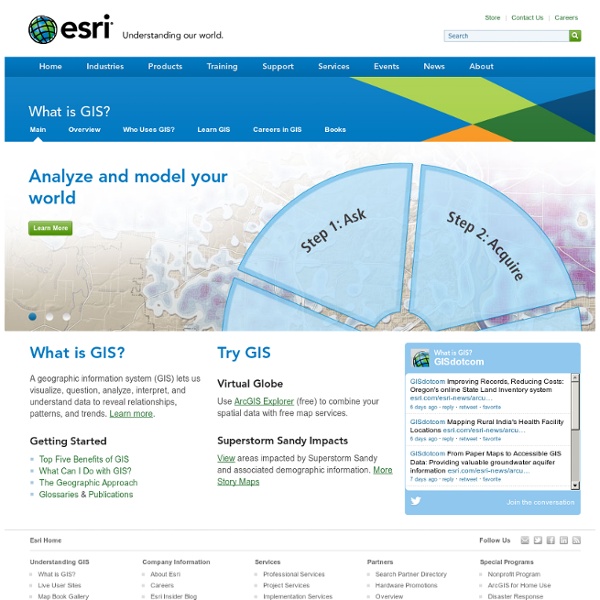



Notes for GIS and The Geographer's Craft Sample Examination and Study Questions Aerial Photography and Remote Sensing by Shannon Crum -- An introduction to the basic concepts of remote sensing, with emphasis on air photograph interpretation. Also includes background on common satellite imaging systems. Application Areas Cartographic Communication by Kenneth E. Foote and Shannon Crum -- These notes include discussions of map elements, effective typography and symbolization, statistical generalization, and trends in computer-aided cartography.
Introducing Teachers That black and white image on the right is a QR code, or a Quick Response code. Once decoded, it would give you the URL for the home page to the Bedford Bits blog. Geographic information system A geographic information system (GIS) is a computer system designed to capture, store, manipulate, analyze, manage, and present all types of spatial or geographical data. The acronym GIS is sometimes used for geographical information science or geospatial information studies to refer to the academic discipline or career of working with geographic information systems and is a large domain within the broader academic discipline of Geoinformatics.[1] What goes beyond a GIS is a spatial data infrastructure, a concept that has no such restrictive boundaries. In a general sense, the term describes any information system that integrates, stores, edits, analyzes, shares, and displays geographic information.
GIS Training from the GIS Software Leader Menu Sign In Training QR Code infographic Embed this infographic on your site <a href=" src=" alt="QR Code - Infographic" title="Qr Code Infographic" width="724" height="1200" /></a><br/><a href=" ID – The The Barcode People</a> Whether or not you realize this, you probably know what a QR code is. They’re everywhere from shipping labels to magazine covers to fliers on community boards. Some companies like Coca-Cola and American Airlines have gotten clever and worked them into their print ads. The question is, what’s stopping you from getting in the game? What is GIS? This is probably the most asked question posed to those in the Geographic Information Systems (GIS) field and is probably the hardest to answer in a succinct and clear manner. GIS is a technological field that incorporates geographical features with tabular data in order to map, analyze, and assess real-world problems. The key word to this technology is Geography – this means that some portion of the data is spatial. In other words, data that is in some way referenced to locations on the earth. Coupled with this data is usually tabular data known as attribute data. Attribute data can be generally defined as additional information about each of the spatial features.
Your Campus Guide When scanned, QR codes such as the one shown above, for Wired Campus, quickly direct users to Web pages on their smartphones. Students touring Wittenberg University, in Ohio, can hear campus history come alive with help from their smartphones and little squares with black-and-white patterns affixed to buildings on the 100-acre campus. Universities like Wittenberg have begun using these QR codes, which can be printed onto any flat surface, as a way to market themselves to a generation of smartphone users. Like bar codes on supermarket items, QR codes–it stands for “Quick Response”–can be scanned by a computer. But instead of returning the price of a carton of milk, these codes are directions to a multimedia-rich Web page. And the scanner, in this case, is the camera in a smartphone.
Historic Preservation in Falmouth Jamaica Graham, Wayne, University of Virginia, wayne.graham@virginia.edu Nowviskie, Bethany, University of Virginia, bethany@virginia.edu Despite the ground-breaking work of graphics visionaries like Alan SutherlandAlan Sutherland built the first graphics program named “Sketchpad” as part of his PhD. work in 1963. Sketchpad allowed users to draw geometric shapes and create copies of them. This work was not only important in the realm of computer aided design (it is viewed as the grandfather of modern CAD software), but also in its organization of the code in objects, which is the basis for modern object oriented design. and Ed CatmullBeyond his current role as CTO of Pixar, Catmull is perhaps one of the most important people in the world of computer graphics, discovering methods to apply images to geometries, smoothing lines drawn on computer screens, among many others.
QR Treasure Hunt A. Prior to the lesson: 1. Arrange students into groups. Conferences and Orientations Audiences for oral presentations and poster sessions at academic conferences often want more information about a particular topic. One way to provide this, obviously, is to create printed flyers or brochures and hope that you’ve brought enough copies for everyone who’s interested. But what if your printed handout doesn’t make it all the way back on your audience member’s trip home? During the 2011 Digital Humanities conference at Stanford University (currently underway) some people are making use of QR codes, a specific kind of two-dimensional bar code (also known as a matrix code). For example, Peter Organisciak gave a talk entitled “When to Ask For Help: Evaluating Projects For Crowdsourcing,” and on one of his presentation slides–as you can see in the photo at the start of this post–he displayed this QR code:
QuickMark - many phones Home Blog Suggestion Box Transaction History Chinese Home Company Profile Contact Us Privacy Policy SiteMap Copyright by SimpleAct, Inc. ® All rights reserved. Software, services and documents in this site are for personal use only. Business use is strictly prohibited without permission from SimpleAct, Inc.